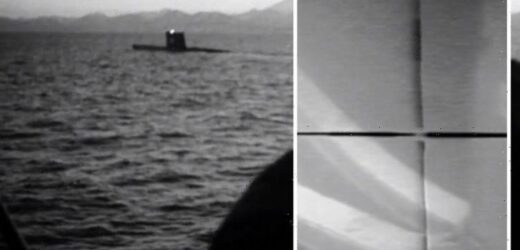CIA project to lift Soviet submarine shown in 1974 footage
We use your sign-up to provide content in ways you’ve consented to and to improve our understanding of you. This may include adverts from us and 3rd parties based on our understanding. You can unsubscribe at any time. More info
On February 24, 1968, a Soviet submarine left a port in Eastern Russia. K129’s mission was to disappear beneath the waters of America’s west coast, armed with three state of the art nuclear missiles that could launch from underwater. Once fired, the missiles are almost unstoppable — each one 65 times more powerful than the bomb that destroyed Hiroshima. Maritime archaeologist Dr James Delgado explained the ocean became the “ultimate cloak” in which militaries could “hide, and wait, and then deliver death”.
Yet, two weeks into K129’s patrol, it missed a scheduled transmission home. Something had gone badly wrong.
A Soviet Navy flotilla scoured the Pacific looking for K219, but were forced to accept defeat after months of searching.
A new investigation uncovered the story, detailed in the recent Channel 5 documentary ‘Drain the Oceans’.
The exact coordinates of the wreck were eventually discovered in August 1968, some three miles beneath the surface.
Recently acquired images showed parts of the wreck, which were then enhanced by expert analysis.


Only some sections of the sub have ever been identified, the clue as to why lies in the stern.
Jagged edges of peeled back metal are, according to the documentary’s narrator, the “telltale signs of a powerful internal explosion”.
Journalist Josh Dean told the documentary: “It’s hard to think of anything more mysterious than K129. It’s an unprecedented wreck.”
In 1968, the Americans noticed the frantic Soviet search, and used their own acoustic technology to try and find a marker for where K129 might be.
Analysis suggested it could have been an underwater detonation. The US Navy closed the file, however, and left the wreck untouched — fearing any tampering with the wreck could spark a war.

Experts believe K129 was likely destroyed by an explosion. The documentary’s narrator added: “But there’s something else, too. Signs that something more than an explosion happened here.”
The nose of the sub is also missing, and had been “cleanly sliced off”.
Mr Dean had been handed video footage from 1974, onboard the ship Glomar Explorer.
The ship claimed to be a deep-sea mining vessel, but “mindboggling” footage showed a hidden cavity within the ship, as well as a hydraulic claw.
The men aboard were CIA operatives, working on the codenamed mission Project Azorian.
DON’T MISS:
Bermuda Triangle breakthrough? Investigators assess Flight 19 claims [INSIGHT]
Archaeology: Shipwreck found in British waters 105 years after it sank [DISCOVERY]
Archaeologists stunned at shipwreck ‘frozen in time’ [QUOTES]

The mission was so secret that most within the CIA were not aware.
A hydraulic claw was designed to retrieve the submarine and its nuclear missiles from the ocean floor.
The old footage shows the claw grasping the wreck. It pulled a 2,000 tonne section away from the sea bed, beginning a three-day long ascent to the surface.
However, two days into the process, a sudden jolt occurred. One of the claws had cracked open.
Most of K129 plunged back into the darkness of the Pacific Ocean, and the CIA was forced to abandon the operation.

K129 remains on the floor of the Pacific Ocean today, alongside its nuclear weapons.
The exact location of the submarine remains an official secret of the United States intelligence service.
A declassified CIA document, however, points to a location of 38°5′N 178°57′E, using various different figures to reach this conclusion. It’s depth is estimated between 5,010 and 5,030 metres.
The official Soviet Navy hypothesis is that K129 slipped below its operating depth and flooded.
Four alternative theories have also been offered — a hydrogen explosion in the batteries while charging, a collision with American submarine USS Swordfish, a missile explosion caused by a leaking missile door seal or an intentional or unintentional scuttling of the submarine.
It is unclear how many more Soviet warheads are lost on the bed of our various oceans.
At least six American nuclear weapons are unrecovered, left behind by the Cold War that abruptly ended in 1989 with the collapse of the Eastern Bloc.
Drain the Oceans is available on My5.
Source: Read Full Article

